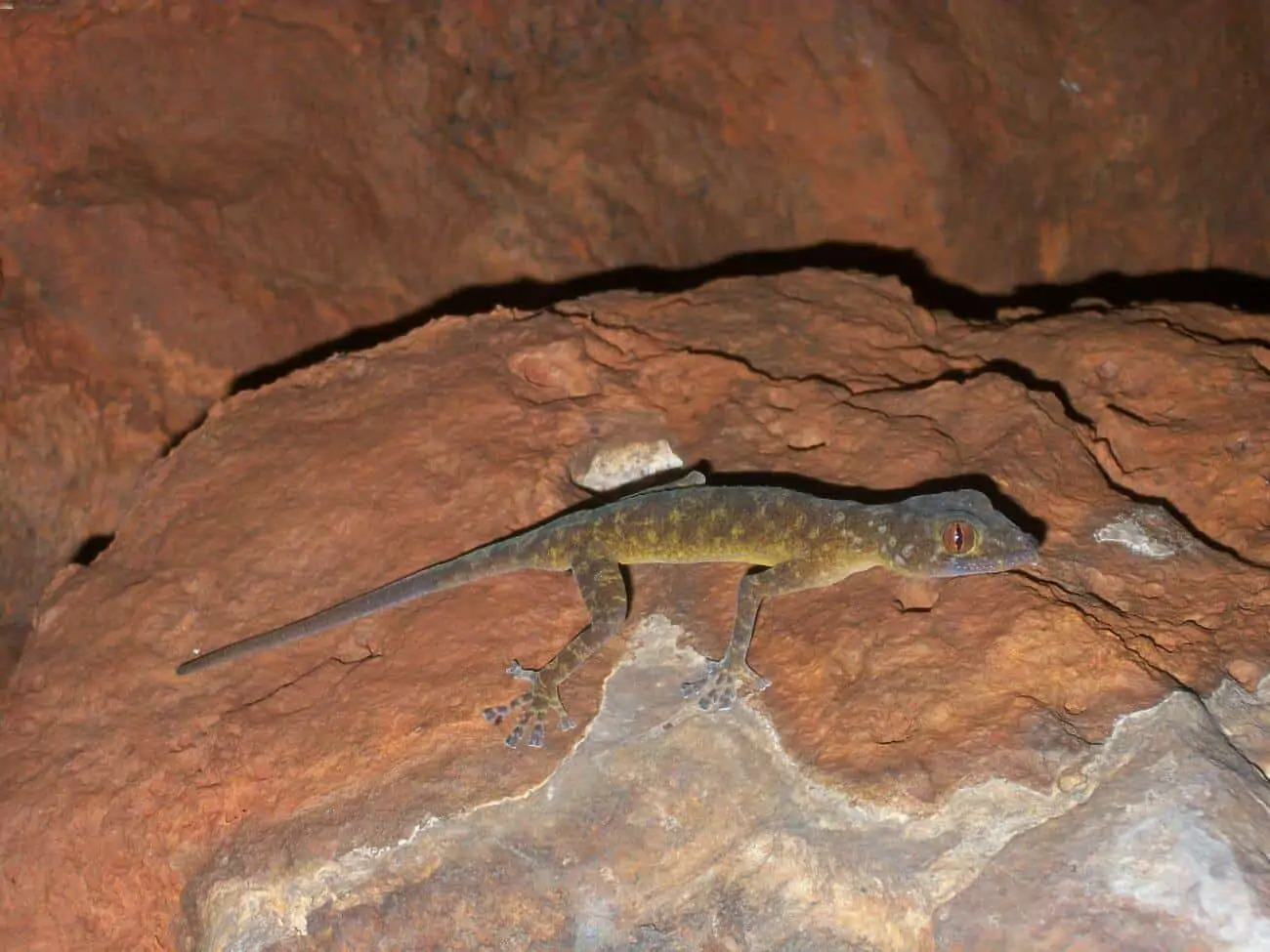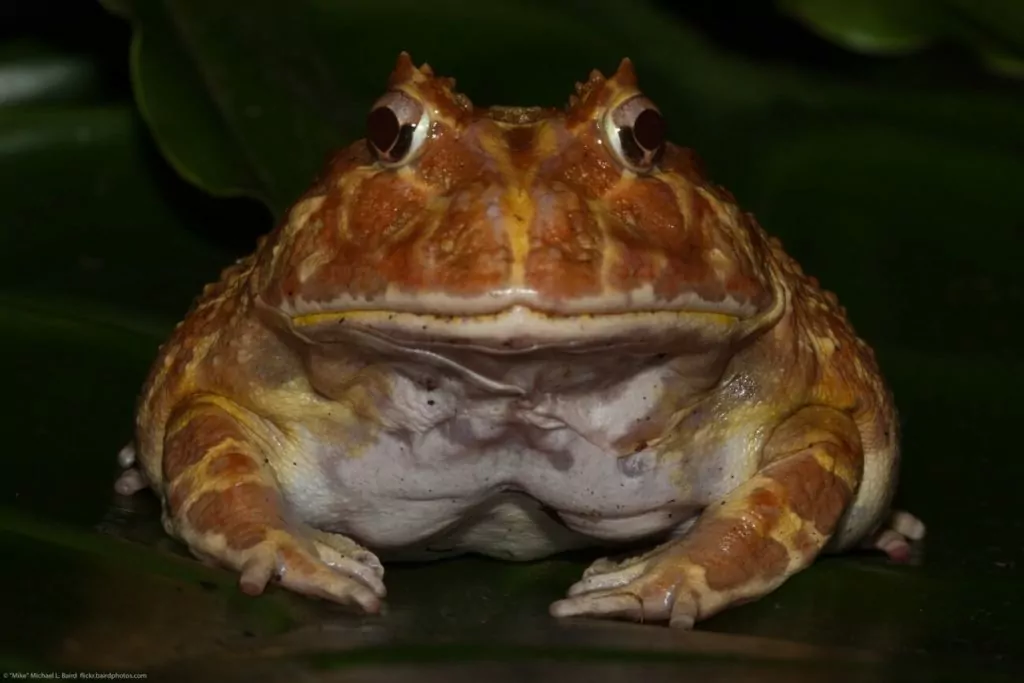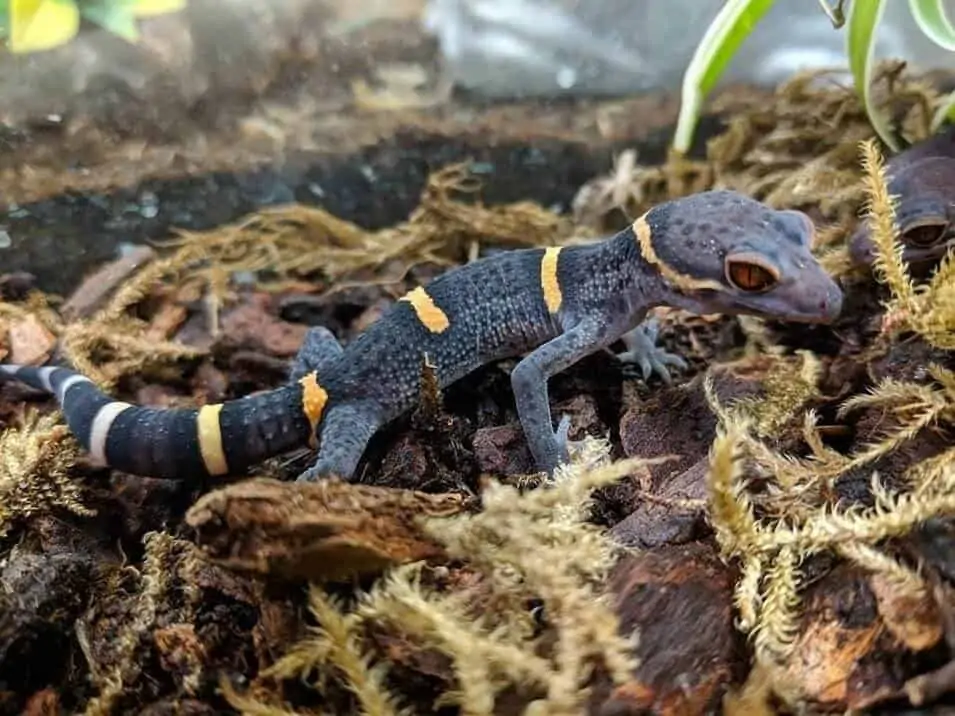Golden geckos are a beautiful reptile that can make great pets. All it takes is a little experience, knowledge, and commitment!
That means if you’re interested in getting one as a pet, you’ll need to familiarize yourself with their care requirements. Fortunately, this guide will help you do that.
Below, we’ll go over golden gecko care in great detail to make sure you’re ready to help your new pet thrive. You’ll learn about their diet, habitat, size, and other valuable info!
Table of Contents
Species Summary
If you’re looking for a less common type of gecko to care for, the golden gecko (Gekko ulikovskii) is an excellent candidate. Despite its beautiful coloration, these lizards aren’t as widespread in the herpetology community. This is likely due to their nocturnal nature and distaste for handling.
But if you’re able to work around their needs, this can be a rewarding pet reptile to care for. Originally from Vietnam and other regions around Southeast Asia, most captive golden geckos are wild-caught. As a result, they can be more of a handful than more common captive-bred pets.
Expert Tip: Golden geckos are best for those with a bit of experience keeping reptiles. However, the husbandry needs of this species are relatively easy to meet if you do your homework. You just need some patience and know-how!
Appearance & Colors
Golden geckos are beautifully colored. Males take on the iconic golden yellow hue. In most cases, the color is uniform throughout the entire body. However, some specimens may have subtle markings of black or green.
Females are a bit darker. They often look closer to brown rather than gold. Most also have more green on the body than females.
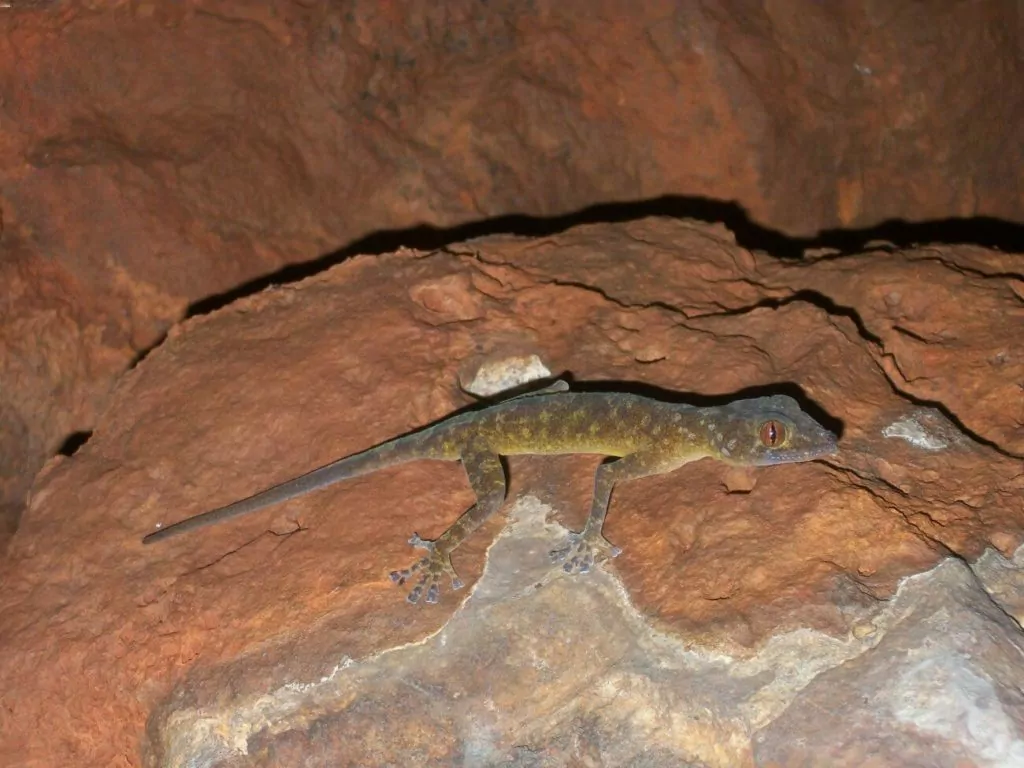
Beyond the intense coloration, golden geckos look like any other gecko species. They’re sporting a triangle-shaped head, big beady eyes, and thin pupil slits.
The tails are long and take up a good chunk of the lizard’s length. On the legs and arms, you’ll find individual fingers complete with fleshy pads for climbing.
Expert Tip: Beyond color, there are some notable differences between males and females of this species. Males tend to be an inch or two longer than females. The male golden geckos also have pores on the inside of their hind legs and fleshy knobs at the base of their tail.
Lifespan
Lifespan can vary from specimen to specimen. Because most are wild-caught, determining the life expectancy of your lizard is nearly impossible.
However, the typical golden gecko lifespan is around 8 to 10 years. This is a bit shorter than the more common leopard gecko.
There are no guarantees with life expectancy, and this is especially true with reptiles that are imported from their natural habitat. The best thing you can do is to provide top-notch care to avoid stress, disease, and an early death.
Average Size
The average golden gecko size is about 7 to 8 inches in length for males, and 6 to 7 inches for females. That puts this species on par with the other popular geckos when it comes to size.
Expert Tip: This length is measured from the tip of the snout down to the tail.
Golden Gecko Care
Golden gecko care can be quite exciting. However, it’s also a lot of work.
Like any other pet gecko, this species requires a well-maintained environment with pristine conditions. It also has some unique needs that you must be aware of if you want them to thrive.
Check out these care guidelines to give your golden gecko the best life possible!
Enclosure Size
The golden gecko is an arboreal species. It spends a lot of time in the wild climbing trees and getting high off the ground.
That means when you’re choosing an enclosure, focus on height rather than floor area.
Generally speaking, a single golden gecko will do just fine in a 20-gallon terrarium. Measurements should be no smaller than 18 inches long, 18 inches wide, and about 24 inches tall. If you plan on keeping a pair or trio of lizards, bump up the minimum enclosure volume to 29 gallons.
A standard glass terrarium is ideal. But, you must ensure that the enclosure has vents of a screened side for proper air circulation.
Expert Tip: You can always go with a bigger enclosure for your pet golden gecko. In fact, we recommend it! A larger enclosure will not cause any stress issues with the golden gecko, so you’re free to create a larger habitat with plenty of quality of life improvements.
Habitat Setup
Creating a cozy environment for your golden gecko is all about recreating their natural habitat. While there’s no concrete information out there, most herpetologists agree that this gecko lives in lowland forests (where the environment is humid, warm, and densely planted).
Start by adding a layer of an absorbent substrate. You want something that will hold onto water to help maintain humidity levels. Newspapers, paper towels, or even reptile carpets are good if you’re on a budget.
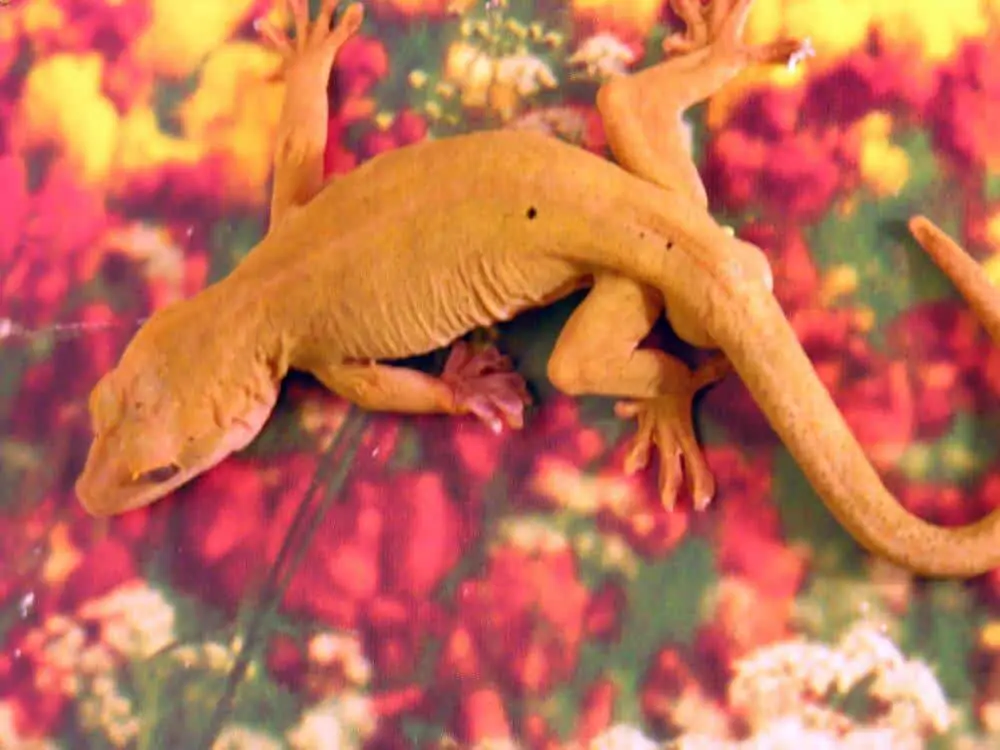
However, more natural options are always better. Try coconut coir, reptile-safe shredded bark, or an organic soil mix without any additives. Whatever you choose, make sure there are no chunks that the golden gecko can swallow. Otherwise, you may have to deal with impaction issues.
Next, use branches, driftwood, corkwood shelves, and branches to create a climbable network of paths. This reptile will spend most of its time climbing, so take some time to ensure that everything is positioned safely and securely.
Golden geckos do spend some time on the ground, so don’t neglect it! Add some artificial hide boxes, overturned logs, and caves for shelter. Then, add live or artificial plants to create a natural look.
Temperature & Lighting
As nocturnal creatures, golden geckos are pretty simple to plan for when it comes to lighting and temperature. You still need to maintain precise temperature ranges, but you can forgo many of the extras.
Like most other reptiles, golden geckos need a temperature gradient. Here are the temperatures to aim for:
- The cool side of the enclosure should have temperatures as low as 75°F.
- On the opposite end of the habitat, temperatures should be close to 90°F.
At night, the golden gecko will tolerate temperatures as low as 70 degrees. Use a heat emitter or heating pad to prevent temperatures from dipping below that.
Many owners like to install infrared bulbs for nighttime viewing. Your standard lights should stay on throughout the day. Your golden gecko will likely sleep while the lights are on. But, they’re still necessary to keep that day/night cycle going.
Expert Tip: Because they are nocturnal, UVB lamps are not necessary. You can install one for good measure, but it’s not a requirement for this species.
Humidity
Golden geckos require high humidity levels. Ideally, the enclosure should have humidity readings between 60 and 80 percent at all times.
Do yourself a favor and purchase a reliable digital hygrometer. This tool will eliminate the guesswork and help you keep humidity levels high.
Regular misting will keep the substrate moist and maintain the desired humidity level in their enclosure. You can also use an automatic mister or dripper system if you want to get fancy.
Water
The most common way that golden geckos stay hydrated is by lapping up water that accumulates on plant leaves after misting. However, this species will also drink from a shallow dish.
Add a small dish and keep it filled with clean, filtered water. Make sure to keep an eye on this dish. It’s not uncommon for geckos to use it as a bathroom! Clean up messes quickly and replenish the water supply.
Golden Gecko Food & Diet
Insects are the name of the game when it comes to diet! Golden geckos love live insects.
Crickets, mealworms, and super worms should be the main diet staple. Occasional snacks of fatty waxworms, roaches, and other insects are fine, too.
Expert Tip: We recommend all the insects in their diet are gut-loaded.
Golden geckos will also accept some fruits. They enjoy mangos, papayas, and bananas. You can even offer up some commercial fruit mashes.
Younger geckos will require daily feedings. But once they mature, you can scale back and feed them 5 or 6 times a week. Provide enough food that your golden gecko can eat in about 15 minutes. They have voracious appetites, so be careful about overfeeding!
Once per week, dust the food in a calcium and Vitamin D3 supplement. This will ensure that your golden gecko is getting all the nutrients they need to stay healthy.
Potential Health Issues
The reason you want to provide calcium and Vitamin D3 supplements is to avoid metabolic bone disease. It’s a common health condition that affects reptiles who aren’t getting enough calcium in their diet to support the bones. In severe cases, golden geckos can suffer from brittle bones and a litany of skeletal issues.
Another common ailment to look out for is dysecdysis. Dysecdysis is the extraneous shedding of the dead outer skin. Shedding is normal. But this disease makes it more difficult for the gecko and can even lead to vision problems.
Dysecdysis is thought to be a product of unhygienic living conditions. Though, parasites and other external factors can lead to issues as well.
The same can be said about respiratory infections and skin-related problems. Golden geckos usually suffer from respiratory infections when the humidity levels and temperature are not correct. Meanwhile, rashes and skin infections are a result of bacteria in the enclosure.
Expert Tip: Staying on top of enclosure conditions is one of the most effective ways to keep disease at bay. Spot clean messes daily and perform a deeper clean once a month. During this deep clean, disinfect every surface to mitigate bacterial problems in the future.
Behavior & Temperament
Golden geckos might be nocturnal, but that doesn’t mean they’re not a joy to watch! Once the lights go out, these pet lizards become very active.
They will explore the enclosure and climb on the network of paths you created. When you feed them, the geckos will hunt down the insects in an intense show of physical prowess! They are fast lizards that have no problem taking down live insects!
Throughout the day, things are a bit different. Most will stay hidden as they rest.
When it comes to behavior, golden geckos can be a bit anxious. This is especially true in the beginning. Your pet will likely calm down and become a bit more docile, but this takes time.
Male golden geckos are also very territorial. You cannot keep two males in the same enclosure. They will constantly fight until there’s only one to claim the territory.
Females are a bit calmer. You can keep one or two females with a single male to keep things peaceful.
Handling
This species isn’t the best for handling. There are a couple of reasons for this.
For one, they are prone to anxiety. An anxious golden gecko will bite you if you attempt to handle it. Not only that, but they might drop their tail. The tail will grow back, but it’s best to avoid causing too much undue stress.
Another reason why handling isn’t a good idea is the gecko’s delicate nature. Their skin is quite thin and breaks easily, making the reptile more susceptible to physical injuries.
As mentioned earlier, golden geckos can become more docile as it gets familiar with you and its surroundings. Once you get to that point, the reptile may be more receptive to handling. But even then, you should never force it!
Be gentle and corral its body carefully to avoid injury. Try to avoid handling as much as possible. This gecko is best observed through the glass of the enclosure.
Conclusion
Golden gecko care shouldn’t intimidate you. As long as you have a bit of experience and a strong understanding of their main requirements, you’ll do a great job!
Let us know if you have any questions that we didn’t answer in this care sheet. It’s hard to include all the facts about this species, so we’re always happy to help you out directly.

